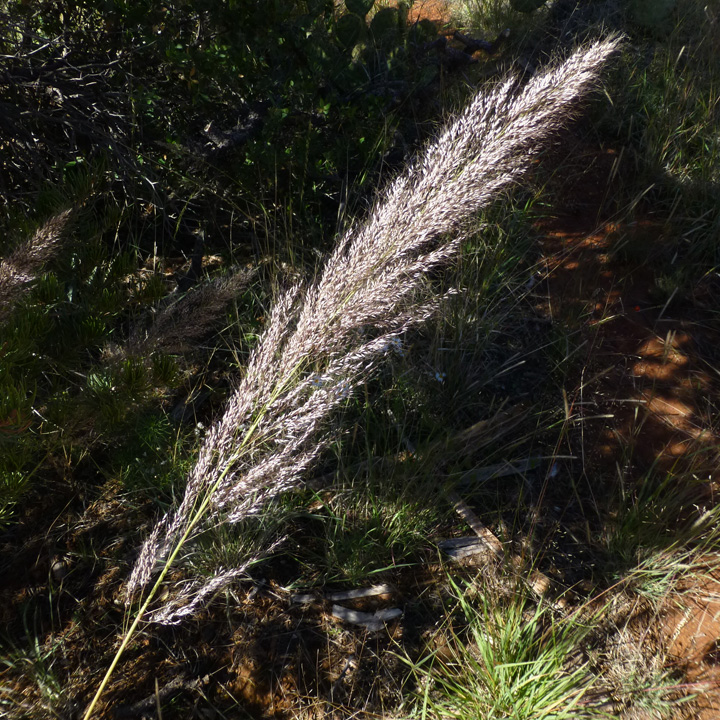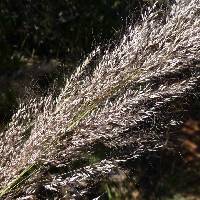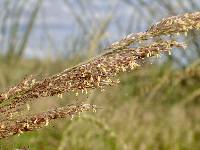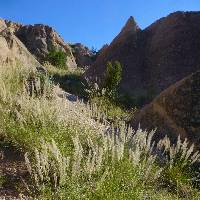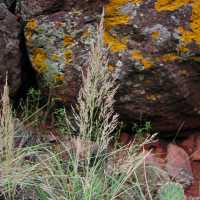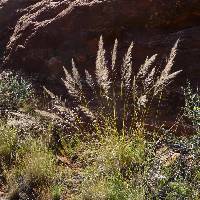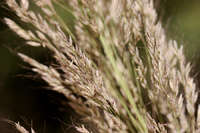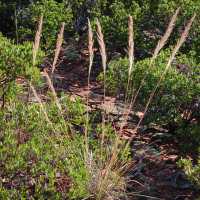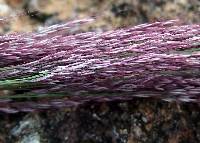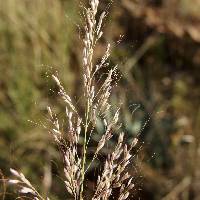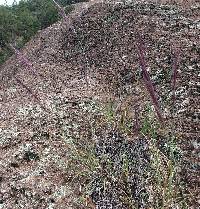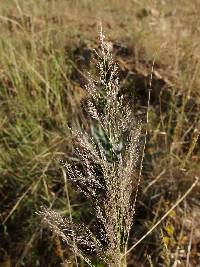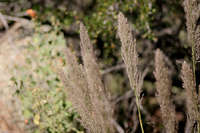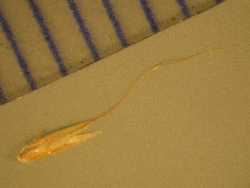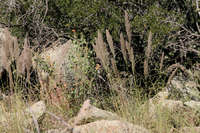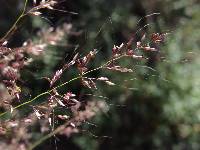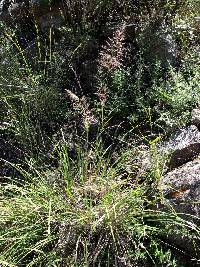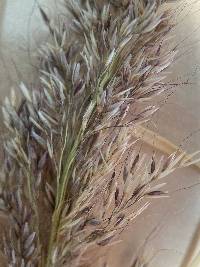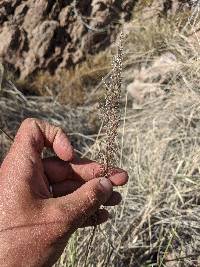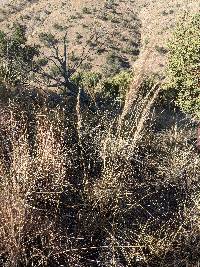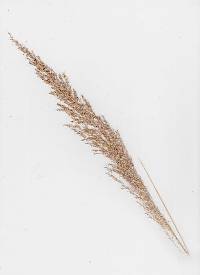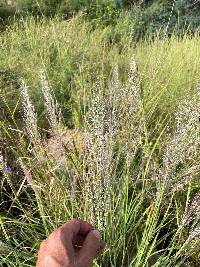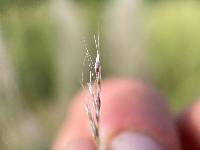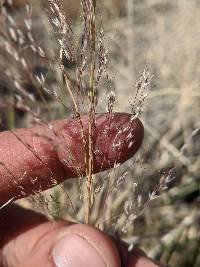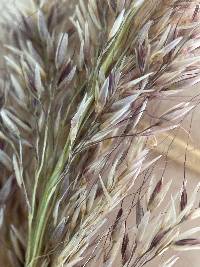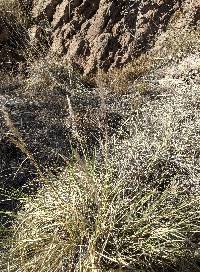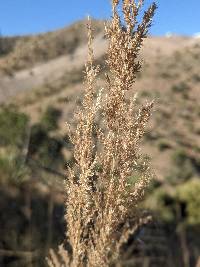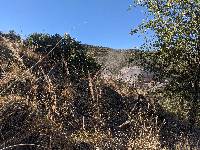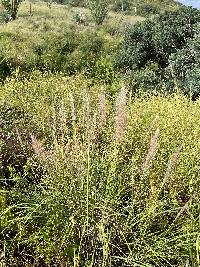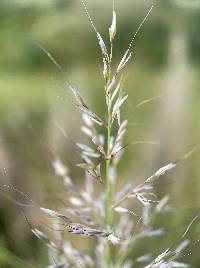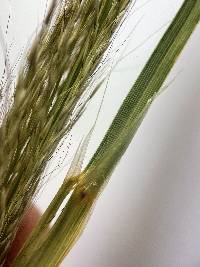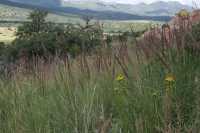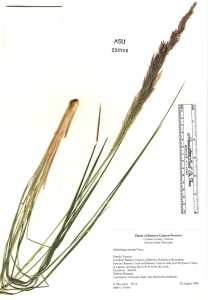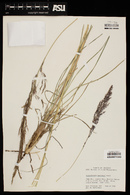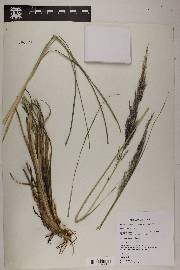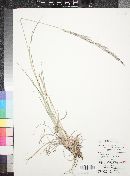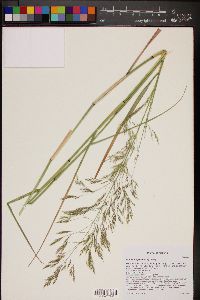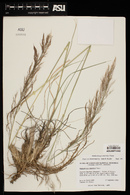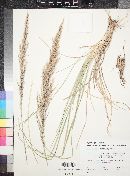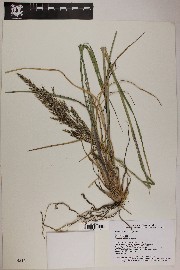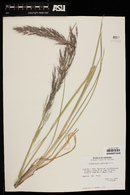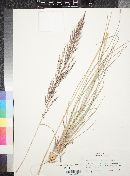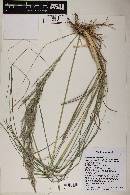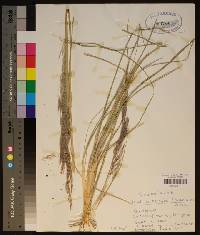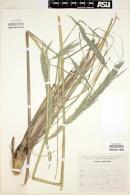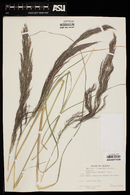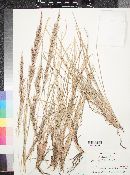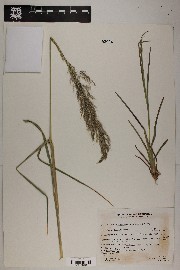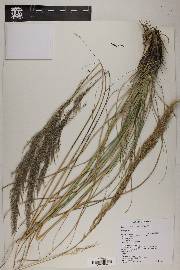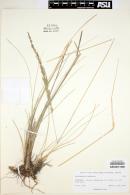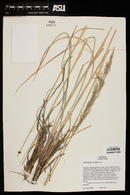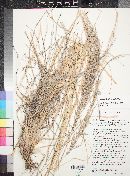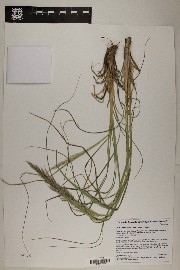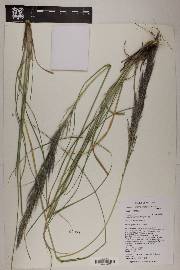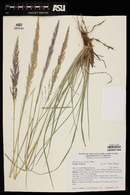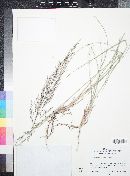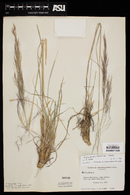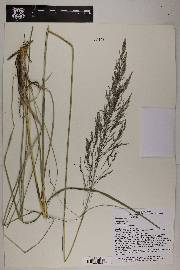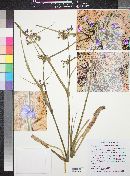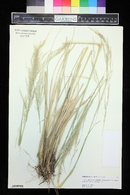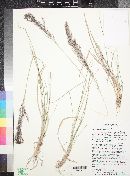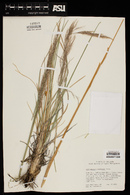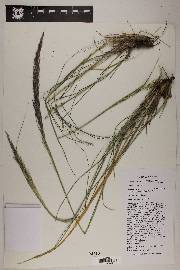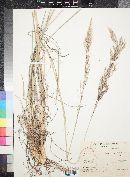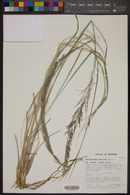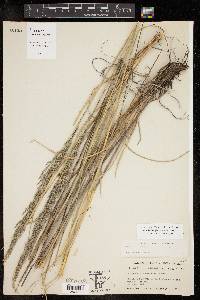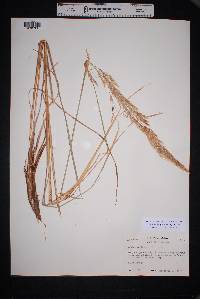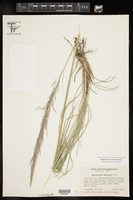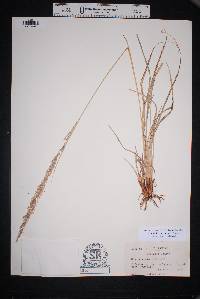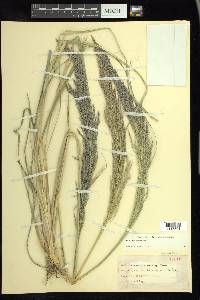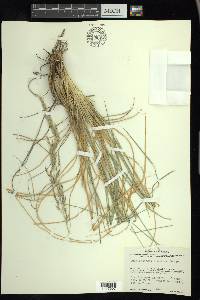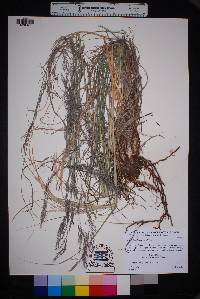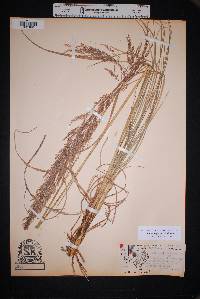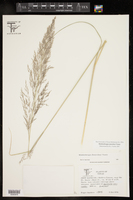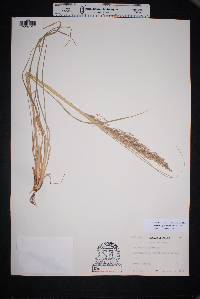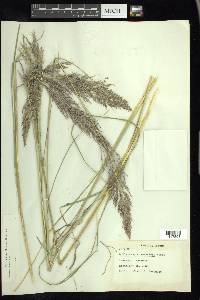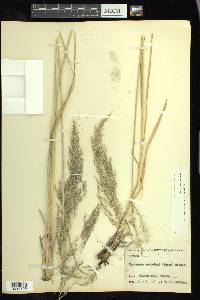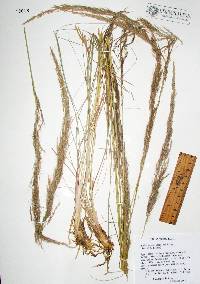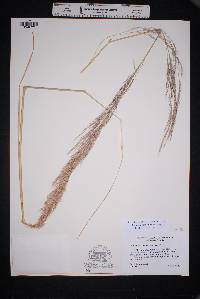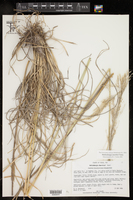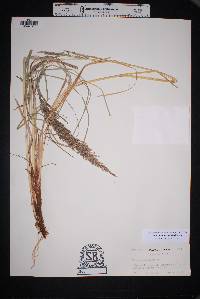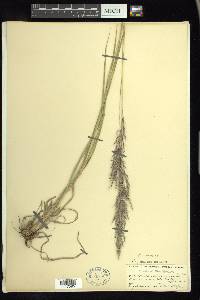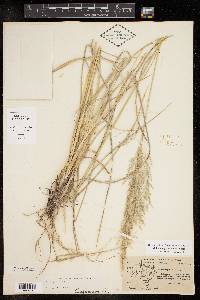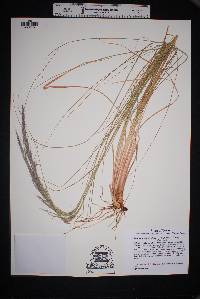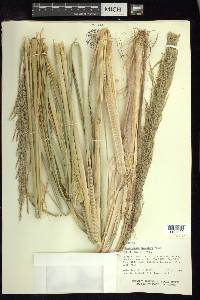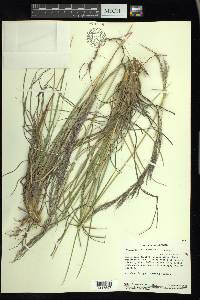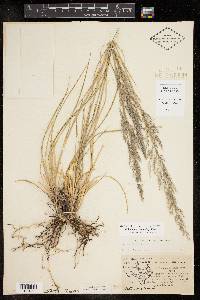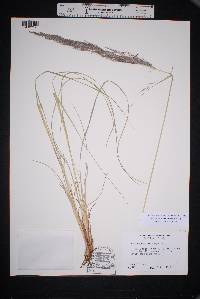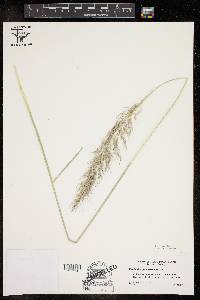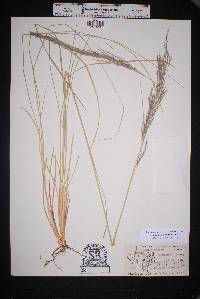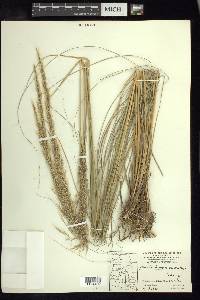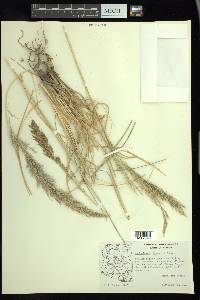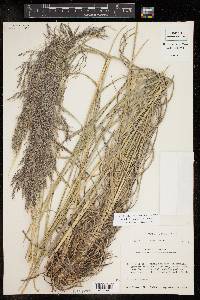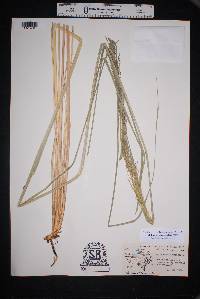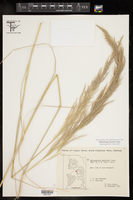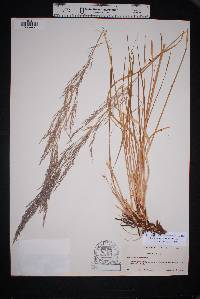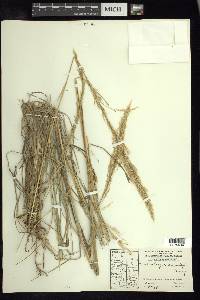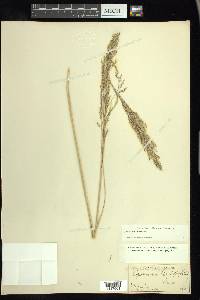Muhlenbergia emersleyi
|
|
|
|
Family: Poaceae
Bull Grass, more...bullgrass, bull muhly (es: cola de zorra, cola de ratón, zacate de toro)
[Epicampes distichophylla Vasey, moreEpicampes emersleyi (Vasey) Hitchc., Muhlenbergia vaseyana Scribn.] |
Plants perennial; cespitose, not rhizomatous. Culms (50)80-150 cm, stout, erect, not conspicuously branched; internodes smooth for most of their length, smooth or scabridulous below the nodes. Sheaths shorter or longer than the internodes, glabrous or puberulent, basal sheaths laterally compressed, usually keeled; ligules 10-25 mm, membranous throughout, acuminate, lacerate; blades 20-50 cm long, 2-6 mm wide, flat or folded, scabrous abaxially, smooth or scabridulous adaxially. Panicles 20-45 cm long, 3-15 cm wide, loosely contracted to open, light purplish to light brownish; primary branches 1-17 cm, lax, loosely appressed or diverging up to 70° from the rachises, naked basally; pedicels 0.5-3 mm, smooth or scabridulous. Spikelets 2.2-3.2 mm. Glumes subequal, 2.2-3.2 mm, exceeding the florets, scabridulous to scabrous, faintly 1-veined, acute to obtuse, usually unawned, occasionally awned, awns to 0.2 mm; lemmas 2-3 mm, oblong-elliptic, shortly pubescent on the lower 1/2-3/4, apices acute, usually awned, sometimes unawned, awns to 15 mm, flexuous, purplish; paleas 1.8-2.9 mm, oblong-elliptic, acute; anthers 1.2-1.6 mm, yellowish to purplish. Caryopses 1.3-1.6 mm, fusiform, reddish-brown. 2n = 24, 26, 28, 40, 42, 46, 60, 64. Muhlenbergia emersleyi grows on rocky slopes, gravelly washes, canyons, cliffs, and arroyos, often in soils derived from limestone, at elevations of 1200-2500 m, and is also grown as an ornamental. Its range extends from the southwestern United States through Mexico to Panama. Muhlenbergia emersleyi differs from the closely related M. longiligula in its compressed-keeled sheaths, pubescent florets, and membranous ligules. Dr. David Bogler, USDA NRCS PLANTS Database Perennials, Terrestrial, not aquatic, Stems nodes swollen or brittle, Stems erect or ascending, Stems caespitose, tufted, or clustered, Stems terete, round in cross section, or polygonal, Stems branching above base or distally at nodes, Stem internodes hollow, Stems with inflorescence 1-2 m tall, Stems, culms, or scapes exceeding basal leaves, Leaves mostly cauline, Leaves conspicuously 2-ranked, distichous, Leaves sheathing at base, Leaf sheath mostly open, or loose, Leaf sheath smooth, glabrous, Leaf sheath or blade keeled, Leaf sheath and blade differentiated, Leaf blades linear, Leaf blades 2-10 mm wide, Leaf blades mostly flat, Leaf blade margins folded, involute, or conduplicate, Leaf blades mostly glabrous, Leaf blades scabrous, roughened, or wrinkled, Ligule present, Ligule an unfringed eciliate membrane, Inflorescence terminal, Inflorescence a contracted panicle, narrowly pan iculate, branches appressed or ascending, Inflorescence solitary, with 1 spike, fascicle, glomerule, head, or cluster per stem or culm, Inflorescence branches more than 10 to numerous, Flowers bisexual, Spikelets pedicellate, Spikelets laterally compressed, Spikelet less than 3 mm wide, Spikelets with 1 fertile floret, Spikelets solitary at rachis nodes, Spikelets all alike and fertille, Spikelets bisexual, Spikelets disarticulating above the glumes, glumes persistent, Spikelets disarticulating beneath or between the florets, Rachilla or pedicel glabrous, Glumes present, empty bracts, Glumes 2 clearly present, Glumes equal or subequal, Glumes shorter than adjacent lemma, Glumes 1 nerved, Lemmas thin, chartaceous, hyaline, cartilaginous, or membranous, Lemma similar in texture to glumes, Lemma 3 nerved, Lemma body or surface hairy, Lemma apex dentate, 2-fid, Lemma distinctly awned, more than 2-3 mm, Lemma with 1 awn, Lemma awn 1-2 cm long, Lemma awn subapical or dorsal, Lemma awns straight or curved to base, Lemma margins thin, lying flat, Lemma straight, Callus or base of lemma evidently hairy, Callus hairs shorter than lemma, Palea present, well developed, Palea membranous, hyaline, Palea about equal to lemma, Palea 2 nerved or 2 keeled, Stamens 3, Styles 2-fid, deeply 2-branched, Stigmas 2, Fruit - caryopsis, Caryopsis ellipsoid, longitudinally grooved, hilum long-linear. Plant: Perennial grass to 1.2 m; panicle 10-40 cm long, many-flowered, usually dense and contracted, branches long; spikelets one-flowered; lemmas ~3 mm long, usually pubescent below, with a slender, flexuous awn 1-2 cm long, borne between the lobes of a minutely notched apex. FNA 2003, Gould 1980 Common Name: bullgrass Duration: Perennial Nativity: Native Lifeform: Graminoid General: Showy perennial bunchgrass with stout, erect, mostly unbranched stems 80-150 cm tall; internodes generally smooth. Vegetative: Leaves mostly basal; blades firm, long, slender, usually folded, 2-6 mm wide, 20-50 cm long, rough-textured on the lower surface and margins, midrib visible on underside of blade; ligule 10-25 mm long, thin and translucent, thin and often rayed/broken at Inflorescence: Large dense panicle, loosely contracted and never widely spreading, 10-40 cm long, light purple to light brown, many flowered, bare of spikelets near the base; primary branches 1-17 cm, lax to loosely appressed; glumes subequal 2-3 mm, membranous, awnless to short-awned, the awns to 0.2 mm; lemma purplish, 2-3 mm long, usually pubescent below, oblong elliptic, with awn 1-2 cm long, from between minutely notched apex. Ecology: Rocky slopes, ledges, forest openings, in dry soil; 3,500-6,500 ft (1065-1980m); flowers June-November. Distribution: AZ, s NM, sw TX; south to n MEX. Notes: Muhlenbergia is a large and diverse genus primarily distinguished by having single-flowered spikelets with unequal glumes. M. emerslyi is common and quite visible on slopes in the desert grasslands, with its basal bunch of long leaf blades, and large dense purple panicle topping an erect culm up to 1.5 m tall. The stems are flattened, the leaf bases folded, and the spikelets are awned. Distinguished from the similar M. longiligula by the flattened stem base, shorter ligule, and awns up to 2 cm long. Ethnobotany: Unknown Etymology: Muhlenbergia is named for Gotthilf Heinrich Ernst Muhlenberg (1753-1815) a clergyman and botanist from Pennsylvania; emersleyi is named for John D. Emersley an American botanist who collected in the Southwest in the 1880s-1890s. Synonyms: None Editor: SBuckley 2010, FSCoburn 2014, AHazelton 2015 |
|
|
|

